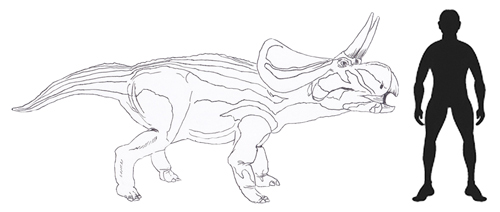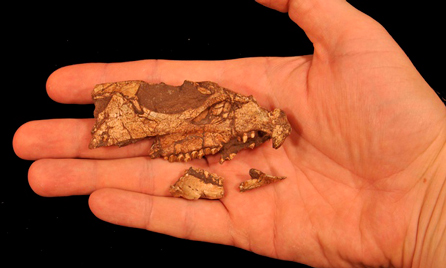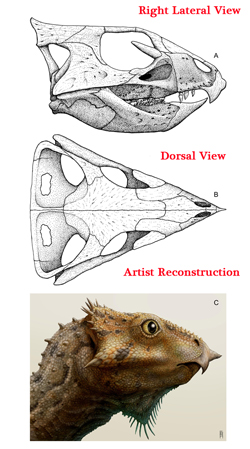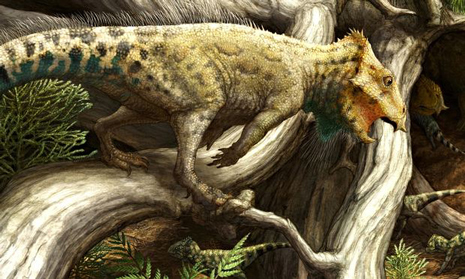Aquilops americanus – The Implications
When it comes to the horned dinosaurs of North America, there has been a lot of focus in the last few years on mapping the extraordinary diversity of ceratopsians that once roamed the landmass known as Laramidia.
There has been much debate over the ethnicity of the Dinosauria, as suggested by the myriad of fossil finds and indeed the debate has been reignited recently with the publication of the research undertaken by the UK’s Dr Nick Longrich and the “northern Pentaceratops” – Pentaceratops aquilonius. Let’s face it, ever since the publication of “New Perspectives on Horned Dinosaurs”, there seems to have been an addition to the Late Cretaceous Ceratopsidae every couple of months or so. For instance, Mojoceratops, Kosmoceratops, Utahceratops, Nasutoceratops, Xenoceratops and so forth.
Finding a New Dinosaur Species
To read about the recent research of Dr Nick Longrich: Finding a New Species of Horned Dinosaur in a Canadian Museum.
However, many scientists have been turning their attention to another part of the horned dinosaur’s family tree. These researchers have been trying to piece together (literally), the fossil evidence that hints at the presence of basal, more primitive members of this great group of ornithischians much earlier in the Cretaceous of North America.
The search for the neoceratopsian dinosaurs, may not garner quite the same publicity as work on their Campanian and Maastrichtian cousins such as Styracosaurus and Triceratops, but this dedicated team are helping scientists to understand how these dinosaurs evolved and migrated out of their Asian ancestral home.
Earliest Horned Dinosaur
That is why the paper published this week in the academic journal PLOS One is so important. This paper describes the partial skull and lower jaw of a horned dinosaur, the fossils represent the earliest evidence of neoceratopsian dinosaurs recorded in North America. Say hello to Aquilops americanus, about the size of a King Charles spaniel that roamed southern Montana somewhere between 109 and 104 million years ago.
A Tiny Skull that is Making a Big Difference
Picture credit: Reuters
Prior to this fossil discovery, the neoceratopsian dinosaurs of North America were represented by isolated teeth and skull fragments, collected from places as far apart as Utah and Maryland, the Cedar Mountain Formation and the Arundel Formation respectively.
The Paucity of the Fossil Record
The paucity of the fossil record was severely hampering the work of scientists as they tried to understand the pattern of migrations between Asia and North America. During the Cretaceous, Asia and North America were joined, they shared a land bridge between them, most likely there were many occasions when fluctuating sea levels and geological activity permitted a land bridge to be formed. It seems that the horned dinosaurs evolved in Asia but migrated via what is now the Bering Straits over to Canada and the United States.
Aquilops americanus
Aquilops seems closely related to Early Cretaceous horned dinosaurs known from Asia such as Liaoceratops and Auroraceratops, it has been speculated that there were at least intermittent connections between these two continents throughout the Late Early Cretaceous, likely followed by a long period of geographic isolation that permitted a number of new genera to evolve before a final reconnection towards the end of the Mesozoic.
The skull measures just 8.4 cm in length, it is likely that Aquilops americanus (the name means “American eagle face”), was an unobtrusive herbivore, selectively grazing young shoots and leaves from the protection of the undergrowth. It may even have been nocturnal or perhaps it may have lived in a burrow.
Line Drawing of the Skull and a Reconstruction of the Dinosaur
Picture credit: PLOS One, life restoration by Brian Engh
The line drawings of the skull have been based on better known neoceratopsian specimens from Asia. Note the large orbit (eye-socket), this has led to speculation that this little dinosaur may have lived in low light conditions or might possibly have been nocturnal.
A Small Herbivore
Commenting on the study, one of the authors of the scientific paper Dr Andrew Farke (Raymond M. Alf Museum of Palaeontology, California) stated:
“This was a small plant-eater and we know from its hooked beak that it was pretty selective, nipping off whatever vegetation was around.”
An Illustration of Aquilops americanus
Picture credit: Brian Engh/Raymond M. Alf Museum of Palaeontology
Studying Ceratopsian Dinosaurs
One of the mysteries with the ceratopsian dinosaurs is when did the Asian migrations occur, and where there any significant migrations of North American fauna into Asia? Before this discovery, the oldest known horned dinosaur from North America was Zuniceratops, which roamed New Mexico and Arizona some 90 million years ago.
A Scale Drawing of Zuniceratops

Everything Dinosaur’s scale drawing of the Neoceratopsian Zuniceratops christopheri. Picture credit: Everything Dinosaur.
Picture credit: Everything Dinosaur
To view replicas and articulated models of horned dinosaurs and other prehistoric animals: Beasts of the Mesozoic Models.
Dr Farke added:
“Aquilops lived nearly twenty million years before the next oldest horned dinosaur named [and described] from North America. Even so, we were surprised that it was more closely related to Asian animals than those from North America.”
The discovery of these fossils, does support the theory that these type of bird-hipped dinosaurs did evolve in Asia and that they spread into North America, most likely via a northern latitude route, however, as the authors of this scientific paper say themselves, more field studies and more fossils will be needed before anyone can state anything else with a degree of certainty.









Leave A Comment